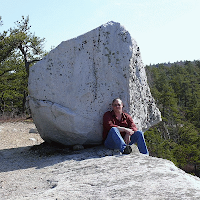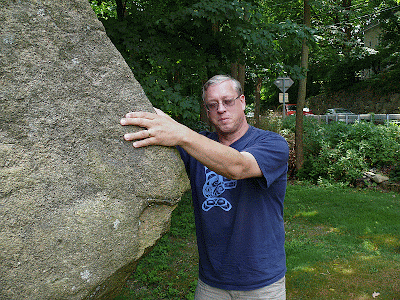Balanced rock is easy to find and visit since it's located right on the side of the road with good parking on town property with a nice interpretive sign.
As the sign says, geologists call this an erratic. I personally don't think it's a man-made dolmen despite its striking appearance, That doesn't mean Native Americans didn't consider it a sacred site, they may have, but I'm not aware of any archaeological evidence for ancient activity here (especially by seafaring Celts!).
The boulder itself is granite and a number of web sources state that it's 16 x 14 x 10 feet in size (I didn't measure it but it seems about right). Let's simplify to 5 x 4 x 3 meters. That's 500 x 400 x 300 cm or 60,000,000 cm3. Granite has a density of about 2.7 g/cm3 which gives us 162,000,000 g or 162,000 kg of mass. That's about 178 tons or three times what is says on the sign (my estimate would be an upper limit since the rock isn't a perfect rectangular box).
However much it weighs, it's a massive rock. The rock is heavily weathered but a close look at the surface in places shows that it's a pink granite (the pink minerals are potassium feldspar crystals). Granite like this is found a bit north in the Hudson Highlands.
The boulder is resting securely on five other rocks (possibly Wappinger Group limestone/dolostone). If you visit, and want to crawl underneath, clear the spider webs before sticking your head in there (I speak from experience).
Despite how precarious it looks, the rock is very stable. Even my kids couldn't push it over!
So, how did something like this form? Well, all over the Hudson Valley of New York we find big boulders sitting around (really, all over the northern parts of the United States). They were picked up and transported by massive continental glaciers during the last ice age (actually, several advances and retreats of glacial ice between 2 million and ten thousand years ago). When the glaciers melted, these rocks, some as large as houses, were dropped out and are known as glacial erratics (I'll show more examples of glacial erratics around the Hudson Valley in another post). While most rocks were dumped onto the ground, this one happened to be dumped onto a few other rocks forming the unique structure we see today.
Here's a neat example of another balanced glacial erratic from near Valtola, Finland that's even larger than the North Salem rock. Called Kummakivi, which translates as "strange rock" from Finn, it's associated with legends of trolls and giants (of course!).
While some websites claim "There is still no scientific explanation for how the rock ... has wound up in such a perplexing position", they are full of shit since any geologist will tell you it's a glacial erratic - the bottom rock even has nice glacial striations (scratches from rocks carried in the bottom of moving ice sheets) clearly visible in many of the photographs of the site.
Back to the New Salem rock. If you search the web, a lot of the information you'll see about Balanced Rock is from New Agers who credulously claim it's a dolmen. Dolmens are megalithic tombs found in various places in Western Europe (most notably Ireland). They typically consist of flat rocks supported by three or more uprights. While superficially looking like a dolmen (not much, in my opinion, since the proportions aren't right), it's far likelier to be a glacial erratic. Nevertheless, I tried pulling some psychic energy from the rock.
My chakras are still tingling.









See if you can find a book by Barry Fell: Titled America BC. When the author saw this rock he believed you should be able to locate an astrological Celtic(?) chamber nearby. He looked at a topographical map, chose an East facing hillside and located the rock lined chamber where the sun reaches the back ONLY on March 21st. Locals said it is an old root cellar -- built with 7,000 lb. lintels!
ReplyDeleteSee if you can find out what happened to Barry Fell after he published the book.
ReplyDeleteNow I'm curious as to what happened to Barry Fell after he wrote the book?
Delete2 facts: Dolmens in France, Scotland, and Ireland predate Celtic culture by thousands of years. And Dolmens, actual megalithic/neolithic tombs, exist in Italy, Spain, Russian, India, Indonesia, and Korea.
ReplyDeleteEven in Scotland and Ireland? Wow. Wonder what culture there was in those areas prior to Celtic. What I mean is that they are hugely influenced based around Celtic tradition.
Delete